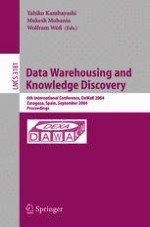2004 | Buch
Data Warehousing and Knowledge Discovery
6th International Conference, DaWaK 2004, Zaragoza, Spain, September 1-3, 2004. Proceedings
herausgegeben von: Yahiko Kambayashi, Mukesh Mohania, Wolfram Wöß
Verlag: Springer Berlin Heidelberg
Buchreihe : Lecture Notes in Computer Science
Enthalten in: Professional Book Archive
